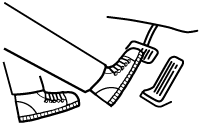 |
BRAKE FLUID AIR BLEEDING
id041100815300
|
Brake fluid type |
|---|
|
SAE J1703 or FMVSS116 DOT-3 or DOT-4
|
1. Switch the ignition ON (engine off).
2. Release the electric parking brake.
3. Switch the ignition off.
4. Remove the cap from the brake fluid reserved tank and add brake fluid.
5. Remove the bleeder cap on the brake caliper, and attach a vinyl tube to the bleeder screw.
6. Place the other end of the vinyl tube in a clear container and fill the container with fluid during air bleeding.
7. Working with two people, one should pump the brake pedal several times and depress and hold the pedal down.
ac4ccw00001649
|
8. While the brake pedal is depressed, the other should loosen the bleeder screw using a commercially available flare nut wrench, drain out any fluid containing air bubbles, and tighten the bleeder screw.
ac4ccw00001650
|
9. Repeat Steps 7 and 8 until no air bubbles are seen.
10. Perform air bleeding as described in the above procedures for all brake calipers.
11. Clean the brake calipers.
12. After air bleeding, inspect the following: